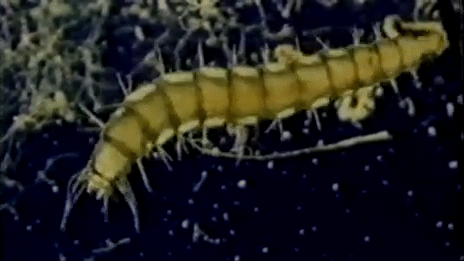
Img 1 A third instar cat flea larva moving by using its labrum (mouth).
Summary
Flea larvae move by contracting and relaxing their skin tube muscle. They attach themselves to the surface using their mouths. Then, once braced, bring their rear-end forward and fasten it to the surface. The mouth relaxes its hold, causing the larvae dart forward in a wriggling motion.
Details
Cat flea larvae are apods (lacking legs). Despite this, they’re quite mobile. However, the larvae rarely travel far.
Forward Movement
To move forward, a flea larva contracts and relaxes its skin tube muscle on a dry surface. Using its labrum (mouth) and nearby bristles, the larva grasps onto the surface. Once braced, it brings its posterior forward and attaches its anal struts (tail hooks) into the surface to prevent backward slipping. The labrum’s hold is then released, and the larva elongates its body to shoot forward in a wriggling motion. The quiet, rhythmic movement resembles that of an earthworm. Bristles covering the bodily segments also help to facilitate the movement.
Stopping
Flea larvae are able to stop themselves by using their mouth parts, or, to a lesser extent, by pushing against the surface with their last body segment.
Coiling
If flea larvae are disturbed or detect vibrations in their environment, they’ll coil up and flip in circles. This behavior, aided by their bristly body, causes the larvae to cling onto carpet fibers. As a result, vacuuming has limited success in removing larvae from carpets.





You must log in to post a comment. Log in now.